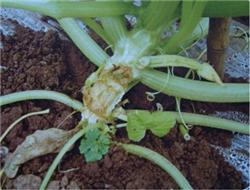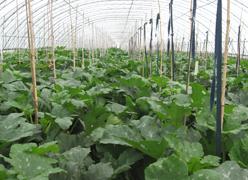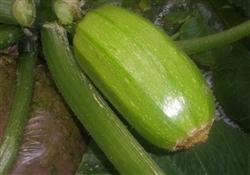Control of soft rot of zucchini

Zucchini soft rot mainly harms the roots and fruits of zucchini. In the melon-bearing period, the stem vine and petiole base first showed a water stain, especially in the natural crack or wound, the rhizome gradually softened, the diseased part was sunken, the internal tissue rotted, forming a grayish brown sticky substance, with a foul smell, water evaporation in the affected part, and tissue shrinkage. The pathogen overwinters in the soil. The soft rot of zucchini in general protected areas is mainly caused by the soft rot of cabbage. The pathogen can only be invaded by the wound through Rain Water, irrigation water and insects. After the invasion, the bacteria secrete Pectinase to dissolve the glue layer, resulting in cell disintegration and intracellular water spillover. Cause rot. High temperature, high humidity, dry pruning and branching of zucchini in rainy days or dew, injury of leaves and insect pests in farmland operation, which often cause bacterial infection and lead to the occurrence of soft rot of zucchini. The prevention and control methods are as follows: disease-resistant varieties should be selected in different areas according to the disease characteristics of zucchini in local protected areas. Agricultural measures to prevent and control 1, avoid continuous stubble with cabbage vegetables, the first stubble choice is onion, garlic or eggplant fruit vegetables. 2. Quicklime or potassium permanganate must be used for soil disinfection before soil preparation. The dosage of quicklime 667 square meters is 50-100 kg, and that of potassium permanganate is 2-2.5 kg. 3. Grafting and raising seedlings. Using black-seeded pumpkin as rootstock for grafting cultivation, the root system of the plant was strong, the low temperature tolerance was improved and the disease resistance was enhanced. 4. High ridge was used to cover plastic film cultivation. 5. rational application of nitrogen fertilizer and increase of phosphorus and potassium fertilizer. 6. Pay attention to irrigation, adopt drip irrigation under plastic film under conditions, avoid flood irrigation, timely drainage after rain, avoid stagnant water in the field; 7. Strengthen the prevention and control of other diseases and insect pests, and mainly do a good job in the prevention and control of whitefly and aphids during the whole growth period. 8. The agricultural operation should be careful to avoid mechanical damage, and the row spacing can be appropriately increased and the plant spacing can be reduced, which is beneficial to the field operation. 9. Remove and bury the diseased melon in time, and disinfect the disinfected melon with quicklime. Chemical control zucchini colonization, pruning before the use of chemical prevention; in the initial stage of the onset of soft rot, 72% agricultural streptomycin and other spraying, alternately sprayed every 7 days, continuous prevention and control 2 Mel 3 times.
- Prev

In the near future, zucchini management and prosperity control is the key point.
Recently, when I went to the countryside, I saw that the greenhouse zucchini planted by vegetable farmers generally grew prosperous, and the plants were bad. Asked why, many vegetable farmers told reporters: "before the weather forecast said that this year is a cold winter, we think that only temperature control can well control plant growth, avoid overgrowth, if the use of plant growth regulation."
- Next

to prevent zucchini from dropping flowers and fruits.
Zucchini strips grow short and thick, which will seriously affect the quality of zucchini and reduce the income of vegetable farmers. Experts suggest that in winter and spring season, zucchini short and thick melon should be prevented early. In winter and spring, the greenhouse temperature and ground temperature were lower, the light was weak, the photosynthetic efficiency of zucchini was low, and the nutrient accumulation of plant body was less. Plus...
Related
- Where is it suitable to grow horseradish in China? it is expected to see the middle altitude horseradish in Alishan.
- How to prevent tomato virus disease reasonably? (Control methods included)
- Many people like to plant towel gourd on the balcony. What are the main points of this method and management?
- What crops can chili peppers be mixed with?
- Fertilization techniques and matters needing attention in Tomato
- What are the grafting techniques for peach seedlings in spring?
- Harm and control methods of root swelling disease of Chinese cabbage
- What are the pests of sweet potatoes? How to prevent and cure it?
- Symptoms, causes and Control methods of navel Rot in Tomato
- The cause of "Cucumber rotten bibcock" in Farmers' planting Cucumber and its Control Plan

